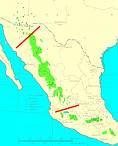Yellow Pine Tree Information
Images of Yellow Pine:






Yellow Pine grows in the following 4 states and provinces:
Arizona, Colorado, Maine, New MexicoInformation about Yellow Pine:
The Pinus Leiophylla Var. Chihuahuana is commonly known as the Chihuahua Pine, Pino Real as well as Yellow Pine.
The currently accepted scientific name of Chihuahua pine is Pinus leiophylla Scheide & Dieppe var. chihuahuana (Engelm.) Shaw. It is a member of the pine family (Pinaceae) . There is disagreement about its taxonomic status; some authors have elevated it to specific status, Pinus chihuahuana Engelm. . Chihuahua pine has three needles per bundle, and ocote (Pinus leiophylla Scheide & Dieppe var. leiophylla Shaw) has five needles per bundle . This report presents information on Chihuahua pine.Chihuahua pine is found in the mountains of southeastern Arizona and southwestern New Mexico . The main part of its range extends southward along the Sierra Madre Occidental to southern Mexico .Chihuahua pine commonly occurs in mixed forests and woodlands composed of evergreen conifers and oaks (Quercus spp.) . It occurs in or just above the Madrean evergreen woodlands and pygmy conifer-oak woodlands . Chihuahua pine extends upward in elevation into the mixed pine (Pinus spp.) and ponderosa pine (Pinus ponderosa) forests . Pine-oak woodlands have a diagnostic understory of evergreen oaks with emergent pines over 16.4 feet (5 m) tall such as Chihuahua pine and Mexican pinyon (Pinus cembroides) . These woodlands are climax over a wide area from southern Arizona to Mexico . Chihuahua pine occurs as scattered individuals in pine forests, often with Arizona pine (Pinus ponderosa var. arizonica), interior ponderosa pine (P. p. var. scopulorum), and Apache pine (P. engelmannii) . Chihuahua pine is the principal tree in the Chihuahua pine series . Minor climax species or codominants with Chihuahua pine in some areas are Arizona pine, Mexican pinyon, Arizona cypress (Cupressus arizonica), and junipers (Juniperus spp.) . Chihuahua pine is subdominant in Apache pine/silverleaf oak (Quercus hypoleucoides) habitat types and white fir (Abies concolor) forests . Chihuahua pine is found as scattered individuals in encinal oak woodlands such as Arizona white oak (Q. arizonica)-silverleaf oak and Arizona white oak-Emory oak (Q. emoryi) community types . It is a characteristic species in Mexican blue oak (Q. oblongifolia) communities . Infrequently, Chihuahua pine occurs in interior chaparral community types such as pointleaf manzanita (Arctostaphylos pungens)-silverleaf oak and pointleaf manzanita-Toumey oak (Q. toumeyi) . Chihuahua pine is a common tree in riparian associations in various communities such as the Arizona sycamore (Platanus wrightii) series and Arizona cypress associations . Chihuahua pine is listed as a dominant or indicator species in the following publications: (1) Classification of the forest vegetation on the National Forests of Arizona and New Mexico (2) Forest and woodland habitat types (plant associations) of Arizona south of the Mogollon Rim and southwestern New Mexico (3) A digitized computer-compatible classification for natural and potential vegetation in the Southwest with particular reference to Arizona (4) Forest habitat types south of the Mogollon Rim, Arizona and New Mexico (5) Preliminary classification for the coniferous forest and woodland series of Arizona and New Mexico (6) A series vegetation classification for Region 3 . Species associated with Chihuahua pine but not previously mentioned in OCCURRENCE AND DISTRIBUTION include Arizona madrone (Arbutus arizonica), Arizona walnut (Juglans major), thinleaf alder (Alnus incana ssp. tenuifolia), pinyon ricegrass (Piptochaetium fimbriatum), and longtongue muhly (Muhlenbergia longiligula) .Some of the information provided here is attributed to:Pavek, Diane S. 1994. Pinus leiophylla var. chihuahuana. In: Fire Effects Information System, [Online]. U.S. Department of Agriculture, Forest Service, Rocky Mountain Research Station, Fire Sciences Laboratory (Producer). , available at the USDA Fire Effects Information System (FEIS) website